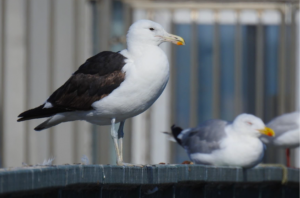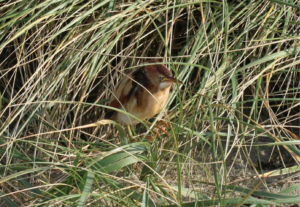Changes to the British List (19 Sept 2023)
The British Ornithologists’ Union Records Committee (BOURC) has accepted the following to the British List.
View the British List
The following species has been added to Category A of the British List:
 Kelp Gull Larus dominicanus
Kelp Gull Larus dominicanus
One, third-calendar-year, Grafham Water, Cambridgeshire, 1-10 August 2022.
Photo (right) © Richard Patient, Grafham Water, Cambs, 8 August 2022
The first record of Kelp Gull in Britain has been long predicted and, although its discovery was perhaps unexpected at an inland site, it appeared with an influx of Yellow-legged Gulls Larus michahellis, which likely acted as a ‘carrier species’ from North Africa and Iberia. Though it was widely suggested that it could be assigned to the South African subspecies ‘Cape Gull’ L. d. vetula, this was not the conclusion of the finder nor BBRC/BOURC, so the record will be published as ‘subspecies undetermined’.
This largely Southern Hemisphere gull species is kept rarely in captivity and is becoming more regular in the Northern Hemisphere with extralimital breeding occurring in Senegal and Morocco in recent years, and a spate of records further north from Spain, Portugal and France.
It should be placed after Great Black-backed Gull Larus marinus on the British List.
Five subspecies are recognised, breeding in South America, Southern Africa, Madagascar, Australia, New Zealand, South Atlantic islands and Antarctica.
The following species has been added to Category A of the British List:
 Least Bittern Ixobrychus exilis
Least Bittern Ixobrychus exilis
One, first-calendar-year, Scousburgh, Mainland, Shetland, 7-8 October 2022, corpse retained, DNA analysis.
Photo (right) © Steve Keightley, Scousburgh, Mainland, Shetland
This bird was found exhausted in sand dunes by a coastal car park on Mainland Shetland, and was subsequently taken into captivity but was severely underweight and died overnight. Analysis of the corpse revealed that it was a first-calendar-year bird, most likely a female. However, its subspecies was not confirmed, but was likely the northern migratory form so will be published as ‘subspecies undetermined, but likely to have been nominate exilis’.
This subspecies is a long-distance Nearctic-Neotropical migrant with no indication that it is held in captivity in Europe, there are previous European wild records from the Azores, Ireland and Iceland, and so was also anticipated as a likely vagrant to Britain.
It should be placed after American Bittern Botaurus lentiginosus on the British List.
Six subspecies are recognised, breeding from eastern Canada to South America, with northern populations of nominate exilis migrating to a non-breeding range from south-west USA to Central America and the Caribbean.
These changes will be published as part of the BOURC’s 56th report due to be published in Ibis in January 2024. Upon publication of this change, the British List stands at 633 species (Category A = 615; Category B = 8; Category C = 10).

